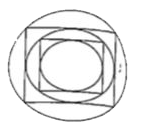What is the distance OA for the square shown in figure :-

The correct Answer is:a√2
Step by step video & image solution for What is the distance OA for the square shown in figure :- by Physics experts to help you in doubts & scoring excellent marks in Class 12 exams.
Updated on:21/07/2023Topper's Solved these Questions
- RACEBOOK - ALLENCHAPTER - RACEEXERCISE - Basic Maths (VECTORS)
57 Videos
- RACEBOOK - ALLENCHAPTER - RACEEXERCISE - Basic Maths (Units, Dimensions & Measurements)
33 Videos
- RACEBOOK - ALLENCHAPTER - RACEEXERCISE - Basic Maths (Graphs))
30 Videos
- NEWTONS LAWS OF MOTIONBOOK - ALLENCHAPTER - NEWTONS LAWS OF MOTIONEXERCISE - EXERCISE-III
28 Videos
- SIMPLE HARMONIC MOTIONBOOK - ALLENCHAPTER - SIMPLE HARMONIC MOTIONEXERCISE - Example
1 Video
Similar Questions
Knowledge Check
What is the inradius of the incircle shown in the figure?
 A9 cmB4 cmCcan't be determinedDnone of these
A9 cmB4 cmCcan't be determinedDnone of theseA graph between the square of the velocity of a particle and the distance(s) moved is shown in figure. The acceleration of the particle in kilometers per hour square is:-
 A2250B3084C-2250D-3084
A2250B3084C-2250D-3084A square is inscribed in a circle then another circle is inscribed in the square . Another square is then inscribed in the circle. Finally a circle is inscirbed in the innermost square . Thus there are 3 circles and 2 squares as shown in the figure . The radius of the outer - most circle is R .

What is the sum of areas of all the squares shown in the figure ?A3R2B3√2R2C3√2R2Dnone of these
What is the name of the microbe shown in the figure?

View SolutionFind out the distance travelled by the blocks shown in the figure before it stops.

View SolutionIn the given figure, PQRS is a square whose side is 8 cm. PQS and QPR are two quadrants. A circle is placed touching both the Quadrants and the square as shown in the figure. What is the area (in cm2) of the circle?

View SolutionWhat is the area of the plot shown in the figure ?

View SolutionA graph between the square of the velocity of a particle and the distance s moved by the particle is shown in the figure. The acceleration of the particle is

View Solution

